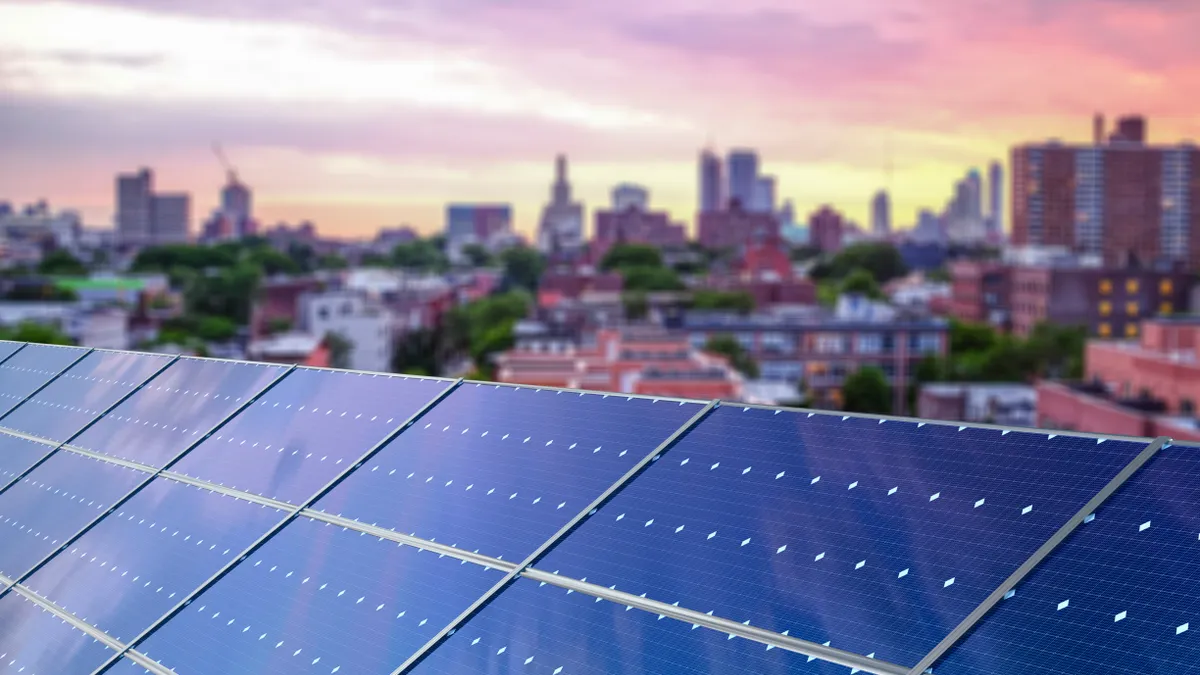Dive Brief:
- New York is moving closer to public ownership and operation of renewable power in state budget legislation being negotiated by Gov. Kathy Hochul, D, and leaders of the Democratic-controlled Legislature.
- The Build Public Renewables Act, or BPRA, requires the New York Power Authority to provide only renewable energy and power to customers and be the sole provider of energy to all state-owned and municipal properties. The legislation also directs certain NYPA projects and programs to pay a prevailing wage sought by unions and to use project labor agreements with construction trade unions, bypassing nonunion employers.
- Much of the BPRA is likely to be included in the budget expected to be sent to rank-and-file lawmakers after Hochul and Senate and Assembly leaders strike a deal in early April, according to its chief sponsor, Assemblymember Robert Carroll, D-Brooklyn.
Dive Insight:
Three versions of the budget are on the table: a measure Hochul included in her proposal that does not include labor provisions sought by unions and socialist advocates; a Senate bill backed by labor and other advocates that incorporates the BPRA; and a state Assembly measure that supports labor and environmental justice standards, but not a provision expanding the New York Power Authority board.
NYPA provides electricity to institutional consumers, municipalities, businesses and other entities and sells power to the market managed by New York ISO.
Unions, grassroots organizations and Democratic Socialists of America chapters organized as Public Power NY have lobbied hard for the legislation. Supporters say it’s the biggest climate bill in the U.S. and will lead to the construction of “publicly owned, 100% renewable energy,” while cutting costs and leading to thousands of jobs that will “finally unionize the green energy sector.”
Carroll said the “likely scenario” is that the budget, which faced an April 1 deadline, will be passed in the coming week or soon after. He said in an interview Thursday he is “cautiously optimistic” the final version will include the labor provisions sought by unions and an expansion of NYPA’s board to include organized labor, environmental justice and renewable energy advocates and others.
Critics say BPRA is unnecessary and “would undermine the current, successful model, which relies on renewable energy and energy storage companies — big and small — to develop these projects to meet New York's energy goals.”
Opposition includes the Independent Power Producers of New York, which primarily represents fossil fuel generators; the Solar Energy Industries Association; and the Alliance for Clean Energy New York that comprises nonprofits such as the Natural Resources Defense Council and private companies including Avangrid Renewables and Invenergy.
NYPA cannot help New York meet its energy and environmental goals any faster than private developers because it cannot complete the siting process more quickly, opponents say. It has not built a new power plant in more than 15 years, but has instead obtained new power supplies through competitive procurement and the competitive wholesale electricity market, they said.
A statement the Solar Energy Industries Association signed with other critics says New York has reached solar power milestones without public ownership of renewables.
“In 2020, New York was the national leader for community solar power installations and was second in the nation for total installations,” opponents said.
James Hanley, who focuses on energy and environmental policy at the Empire Center for Public Policy, a free-market think tank, said the timeline for NYPA to build or buy only renewable power is “politically motivated” and overly ambitious. The legislation requires NYPA to provide only renewable energy by 2030 and renewable energy to all state-owned and municipal properties by 2035.
He also criticized BPRA for its proposal to expand NYPA’s board to 17 from seven members and include labor and other advocates that supporters say will make the agency’s governance more democratic.
“It’s going to push and pull the agency in all sorts of directions instead of providing affordable and reliable energy,” Hanley said.
Hochul has signed on to an expanded role for NYPA, but not as broad as unions, socialists and grassroots organizers want. In her budget in January, the governor proposed authorizing the agency to finance, build, own, operate and maintain renewable energy projects. But she’s balking at provisions strengthening the role of organized labor in building renewable power facilities.
Public Power NY has waged a public lobbying campaign urging Hochul to sign on to the broader version that has passed the Senate. And nine members of New York’s congressional delegation wrote to Hochul March 29, urging her to incorporate the Senate version of the BPRA that includes labor and other provisions they said would help draw federal funding.
“As you work with the legislature to finalize the budget, we believe that making certain improvements to your proposal would allow New York to maximize the funding opportunities created by the Inflation Reduction Act (IRA) — and indeed, to demonstrate for the country how to realize the highest aspirations of the IRA,” they said.
Days before a final budget is expected, little is certain. “Let’s not take a victory lap,” Carroll said.
He credited advocates for helping advance the bill as far as it has, four years after he first introduced it.
The ideological shift in the Legislature also has been a significant factor in the changing politics of energy in New York. Democrats won a majority in the Senate in 2018 for only the third time in 50 years and have since expanded their margin. It was previously the last Republican bastion in New York state government where Democrats controlled the state Assembly for decades and occupied the governor’s office since 2007.
Carroll said the BPRA has advanced on its merits.
“At the end of the day it’s a good idea,” he said.















